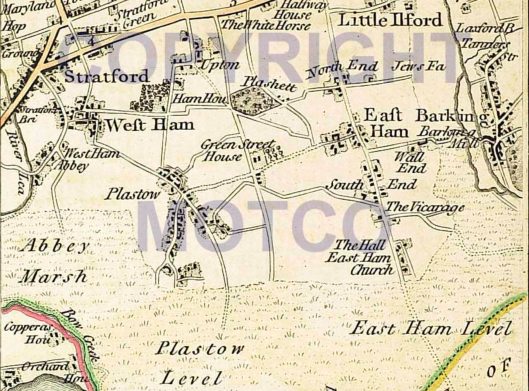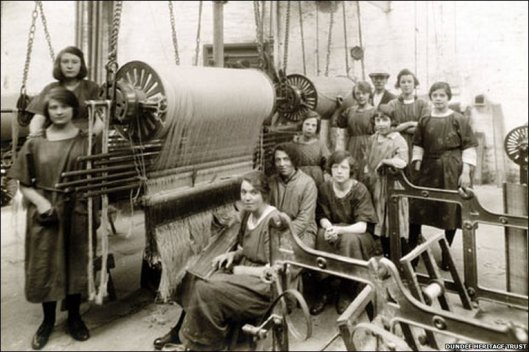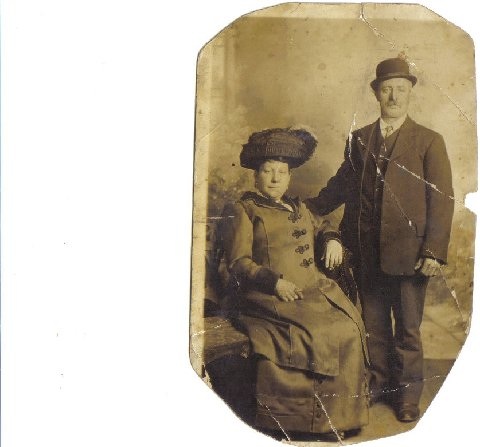The last few posts have followed the lives of the children of my great great grandparents Daniel and Mary Ann Roe, after their deaths in 1870. We’ve seen that John Richard Roe died just a few years after his parents, at the age of sixteen, while Daniel Ellis Roe spent some time in the army and then in civilian life as an engineer, before dying after a fall from a ladder at the age of thirty-six. Kezia Eliza Roe married frame-maker Edward Temple but they seem to have had no children, while Mary Ann Blanch Roe married actor Leonard Kew and made a name for herself on the stage as ‘vocal comedienne’ Blanche Vincent.

Soho Parish School, 23 Great Windmill Street, built on the site of the house where Joseph Priestley Roe was born, which was demolished in 1870 (author’s photograph)
In this post I’ll explore the life of Daniel and Mary Ann Roe’s youngest child, my great grandfather Joseph Priestley Roe. Born in 1862 at 23 Great Windmill Street, Soho, Joseph was just eight years old when his parents died. In 1871, while his brothers and sisters were being looked after by their grandmother Keziah Blanch in Broad Street, Soho, nine-year-old Joseph was in the care of his uncle and aunt, Thomas and Eliza Parker, at their home in Albany Road, Camberwell. Eliza Parker née Roe was his late father Daniel’s sister.
At some point in the next ten years, Joseph went to live with another aunt and uncle in Grange Road, West Ham. Emma Trader née Blanch was the sister of Joseph’s late mother, Mary Ann Roe née Blanch. Her husband, Walter Trader, worked as a butcher, and it’s possible that Joseph’s move to West Ham was motivated by a need to find work. The 1881 census finds him living with the Traders and working as a butcher’s assistant, presumably with his uncle Walter.

Marriage certificate for Joseph Priestley Roe and Eliza Bailey
Two years later, on 25th November 1883, Joseph Priestley Roe married Eliza Bailey at St Anne’s church in Limehouse, which was, as we’ve noted before, a favourite of Joseph’s family: his parents Daniel Roe and Mary Ann Blanch had married there in 1848, as had his grandparents John Blanch and Keziah Holdsworth in 1827. At the time of their marriage Joseph was twenty-one and Eliza was eighteen. They both gave their address as 56 Church Row, which was close to St Anne’s church and may have been an address of convenience to enable them to marry there. Joseph signed his full name, but Eliza made her mark. Joseph was working as a carman, i.e. the driver of a horse-drawn vehicle. The marriage was witnessed by Eliza’s father, William Bailey, a labourer, and by Flora Blanch, who was Joseph’s cousin, the daughter of his mother’s brother John Holdsworth Blanch. Flora seems to have been looked after by her grandmother Keziah Blanch from an early age; in 1883 she would have been just fourteen years old.

Barking, Wall End and East Ham in J. Cary’s Map of Fifteen Miles Round London, 1786 (via motco.com)
The Baileys had lived in Barking and worked as farm labourers for at least two generations. The earliest record we have for Eliza Bailey’s father William is the 1841 census, which finds him, aged sixteen, living with his parents and family in North Street, Barking (not far from Cowbridge Lane: both roads still exist). From this record we know that William was born in about 1824 and that he was the eldest of the four children of John Bailey, who was born in about 1801, and his wife Eliza, born in 1802. Like his father, William worked as an agricultural labourer. His younger brothers and sisters were Sarah, born in 1828; John, 1831; Mary, 1834; and Louisa, 1837.
William’s father John Bailey must have died before the 1851 census, which finds his widow Eliza, aged forty-eight, living at Mumdays Rooms, close to Barking High Street. With her are daughters Sarah, twenty-two; Mary, eighteen; and Louisa, fourteen. All except Louisa are described as field labourers. We also learn from this record that, though the children were all born in Barking, their mother was originally from Bishops Stortford.
By 1851 William, now twenty-six years old, was married to Elizabeth, twenty-five. They were living at Wall End, Barking Road, East Ham, with their children Louisa, two, and John, one month. William is said to have been born in Barking and his wife and children in East Ham, so it’s likely they had been living at this address since they were married, probably in about 1848. Both William and Elizabeth are described in the census record as agricultural labourers.
The Baileys’ immediate neighbours in 1851 were also farm workers, although a few doors away lived a police constable, and beyond him one Jabez Abbott, a farmer of 105 acres employing eleven labourers (was William Bailey among them?). At the time Wall End was a hamlet on the Barking border, linked to East Ham High Street by Barking Road.
Ten years later the Baileys were still in Wall End, though they appear to have moved house. Now they were two doors away from the Duke’s Head pub, separated from it only by the home of forty-eight-year-old Halifax-born Chelsea Pensioner William Barrand. The Duke’s Head still exists in Barking Road, though it was rebuilt early in the twentieth century. In addition to Louisa, twelve, and John, ten (who despite his young age ‘works in fields’), they now have two other children: Thomas, eight, and William, four.

Map of East Ham and Barking from 1894-1896, with Wall End and Duke’s Head pub visible in the centre, and fields still existing between the two towns.
In 1871 William and his family seem to be at the same address, though the house between them and the Duke’s Head (where the lodgers include three unnamed circus performers) is now occupied by retired Norfolk fisherman High Campbell (whose household includes visiting Swedish tailor John Stare). Besides William and Elizabeth, both aged forty-seven, the Bailey household consists of John, twenty, Thomas, eighteen, William, fifteen, and Joseph, ten, all of them farm labourers like their father – as well as Eliza, my great grandmother, whose age could be read as either five or eight, but is almost certainly the latter, given that she is said to be seventeen years old in the 1881 census record. This means that she was born in either 1863 or 1864.

Young women working in a jute mill (via news.bbc.co.uk)
The most surprising revelation in the 1871 record is that, at eight years old, Eliza was already working in a jute factory. Jute is a vegetable fibre that can be spun into coarse, strong threads. The Barking Jute Works opened in 1866 and according to the local authority’s website:
The majority of the jute workers were young females, usually single and often away from the control of their families. Determined to enjoy themselves they developed a reputation for drunken brawling at weekends and bank holidays which made the town notorious in the 1880s and 1890s.
The website claims that the youngest worker was ten years old. However, Eliza’s involvement may be explained by this note:
Outwork was provided for local Barking women and children in the form of sack sewing. The cloth was cut to size in the factory and carried home along with hanks of tarred twine. The sacks were sewn at home and then returned to the factory for payment.
By 1881 the Bailey family address appears to have changed again. Their address is given simply as ‘Cottage, High Street, Wall End’. Chapel House and Abbotts Farm Cottage are to one side (the Baileys’ neighbour John Archer is said to be the foreman at Abbotts Farm), but there is no sign of the Duke’s Head. The Bailey household consists of fifty-six-year-old William and Elizabeth, their son John, twenty, a general labourer, and seventeen-year-old Eliza, who is still working as a jute spinner.

Eliza Roe née Bailey and Joseph Priestley Roe
Two years later Eliza married Joseph Roe. By the time of the 1891 census, just eight years after their marriage, Joseph and Eliza already had six children: twins Joseph William and Mary Elizabeth, both born in 1884; Emma Kezia, 1886; Walter Ellis Roe, 1887; Richard Roe, 1888; and Flora Eliza, 1889.
The census record finds them living, together with Eliza’s parents, at 36 Denmark Terrace, East Ham, which I assume was close to the Denmark Arms on the corner of Barking Road and East Ham High Street. Joseph is now working as a dock labourer, but his sixty-seven-year-old father-in-law William Bailey seems still to be working as a farm labourer.
By 1901 Eliza and Joseph had two more children – William Thomas, born in 1892, and John, born in 1895 – and had moved, together with Eliza’s parents, now aged seventy-five, to 313 Barking Road. William is still working and is described in the census record, like his son-in-law Joseph and sixteen-year-old grandson Joseph William, as a ‘general labourer’’ Joseph and Eliza Roe’s youngest child, Minnie Louisa – my grandmother – would be born on 20th April 1902.

Junction of Barking Road and East Ham High Street, early twentieth century (via pubs history.com)
I don’t know when William and Elizabeth Bailey died, but they were no longer living with Eliza and Joseph at the time of the 1911 census, so I assume they had died at some point in the first decade of the century. The census record finds Joseph, forty-eight, and Eliza, forty-seven, living at 92 Oakfield Road, East Ham, with their son Richard, twenty-eight, a general labourer; Flora, twenty-two, a laundress; Elizabeth, twenty, also a laundress; William, eighteen, and John, seventeen, both office boys at John Mowlam Construction; and Minnie, eight.
The names given to their children by my great grandparents Joseph and Eliza Roe offer clues as to the significant people in their lives. It’s clear that Joseph William Roe was named after his father, and his maternal grandfather, William Bailey. His twin sister Mary Elizabeth must have been named after her two grandmothers, Mary Ann Roe and Elizabeth Bailey. Emma Kezia was probably named after Joseph’s aunt Emma Trader, with whom he lived as a young man, while Kezia may derive from his maternal grandmother, Keziah Blanch née Holdsworth, or from his older sister with the same name.
Walter Ellis was probably named after Joseph’s uncle Walter Trader, for whom he had worked as a young man, while his middle name reflects the close ties between the Roe, Blanch and Ellis families that I explored in this post. Flora Eliza bears the name of the cousin who was a witness at Joseph’s wedding, while her middle name probably derives from her mother. Elizabeth, William and John were important Bailey names: the first two were the names of Eliza’s parents, but she also had brothers named John and William, and a grandfather named John. The latter was also the name of Joseph Roe’s older brother.

Joseph and Eliza Roe
Joseph Priestley Roe died in 1947 at the age of eighty-five. His wife Eliza lived for another twelve years, in the home of her daughter Minnie, my grandmother, at 24 Oakfield Road, East Ham. I have faint memories, from the early years of my childhood, of going to visit my Nan and Grandad and being aware of a very old lady who lived upstairs. Apparently my great grandmother couldn’t get used to my name – Martin – and insisted on referring to me, using my father’s name, as ‘Little Peter’. Eliza Roe née Bailey died in 1959 at the age of ninety-six.
In the next post I’ll explore what became of Joseph and Eliza Roe’s children.
